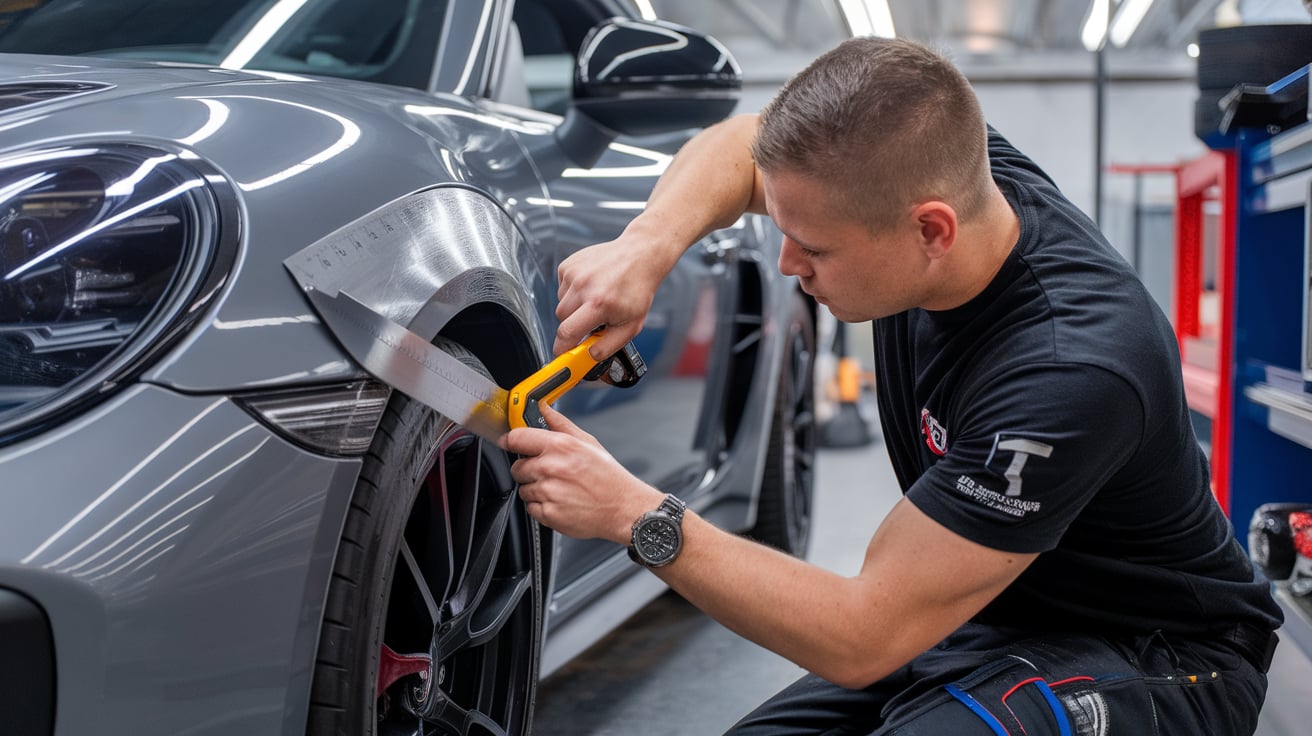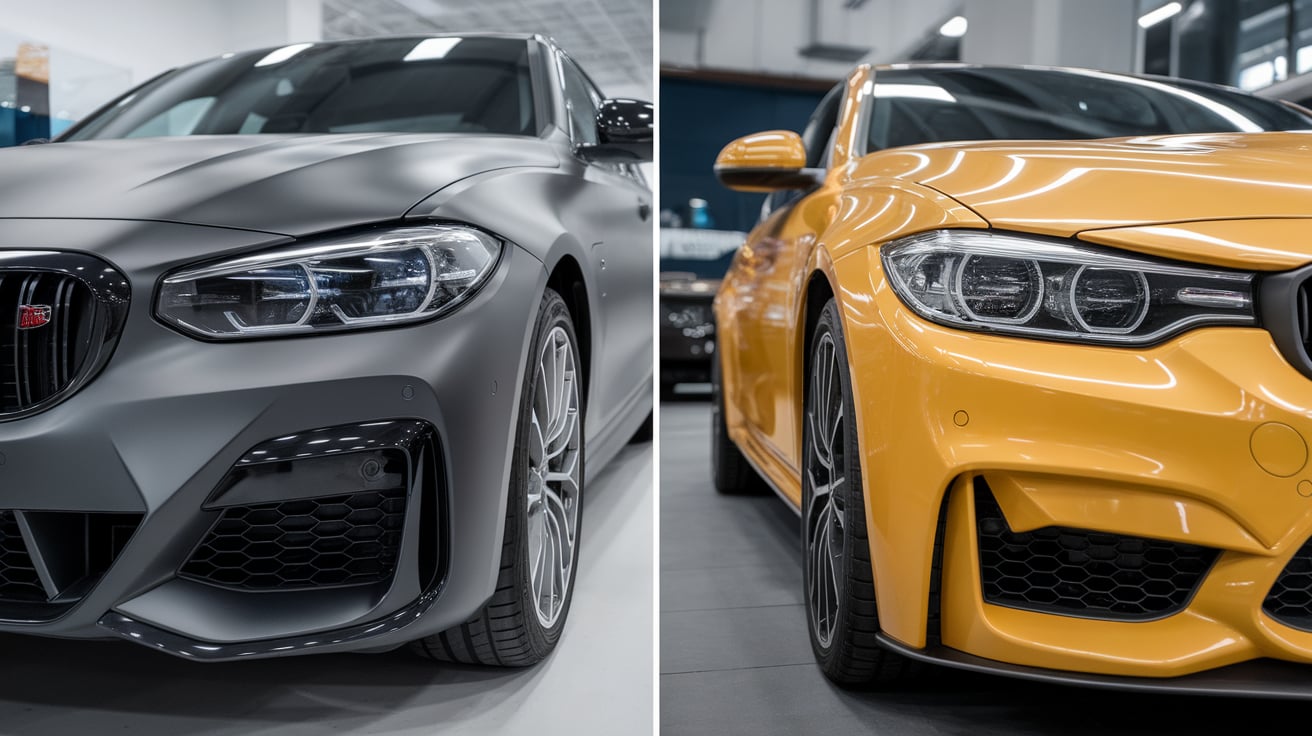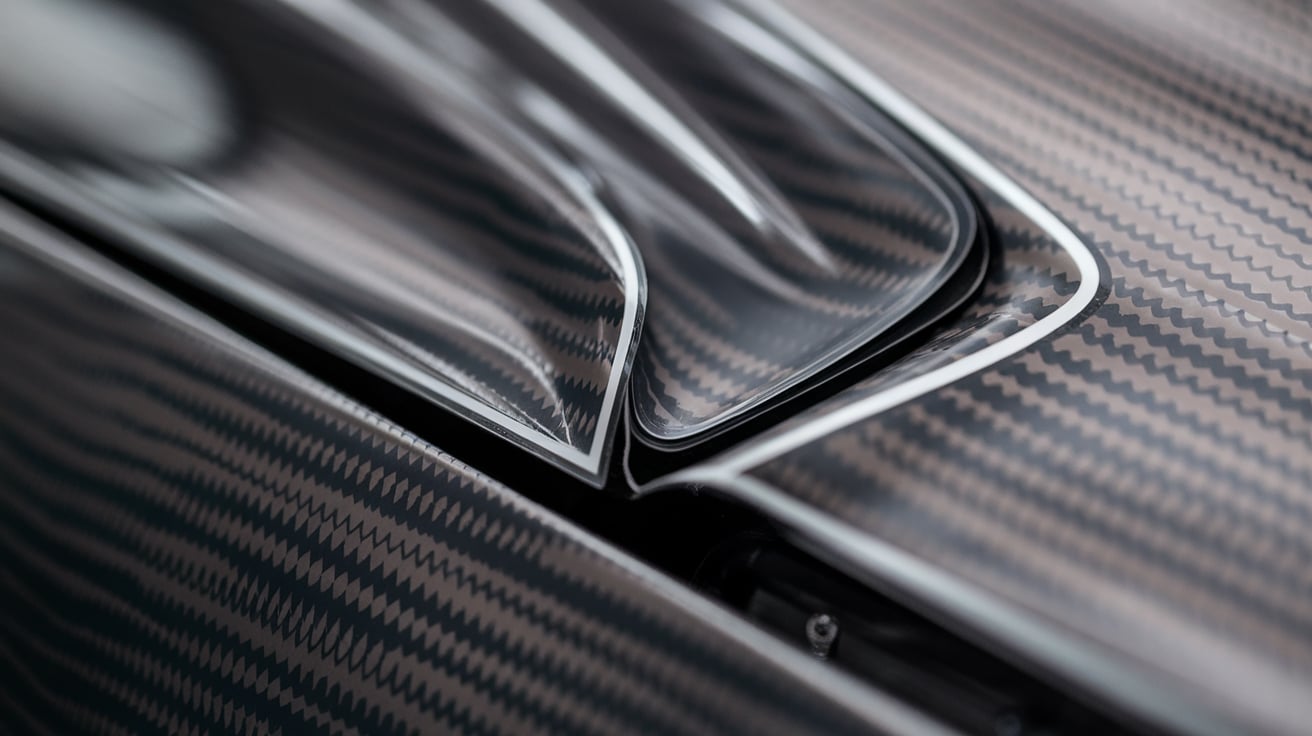- Follow Us On Facebook

Laser Cutters vs Manual Cuts in Vinyl Wrapping | which is best?
What if one wrong cut ruins your entire wrap job? Sounds extreme, but it happens more often than you think. In the world of vinyl wrapping, precision is everything, especially during cutting. Whether you are using laser cutters or going old-school with manual cuts, the method you choose affects more than just the finish. It impacts speed, material waste, edge quality, and even long-term durability. This guide breaks down the real difference between manual cutting tools and laser cutting machines in car wrap installations, so you can choose the one that works best for your workflow.
Understanding the Basics of Vinyl Wrap Cutting
Before you decide what tool to trust, a laser cutter or your own hand, you need to understand how each method actually plays out on the job. One bad cut does not just ruin a panel. It eats up time, material, and your patience. That’s why the method you use matters more than most people think.
Manual Cutting in Vinyl Wrapping
This is where it all started: a sharp blade, a steady hand, and full focus.
- Tools: Most installers stick to utility knives, knifeless tape, and edge-protected squeegees.
- How It’s Done: The wrap is first applied, then trimmed along body lines, badges, or panel gaps.
- What It Demands: Skill. You are cutting right on or near the vehicle, and there’s no room for second chances.
- When It Works Best: Smaller wraps, touch-ups, or areas with tough curves that machines can’t read.
- What Could Go Wrong: A slip too deep, and you are into the paint. Or worse,uneven edges that show once the wrap shrinks.
Manual cutting gives full control, but it needs experience. If your hand shakes, the finish pays for it. For precision work, we also offer car stripes installation to add sharp detail without compromising your paint.

Laser Cutting for Car Wraps
Now let’s flip to the tech side: digital layouts, clean cuts, and no second-guessing.
- The Process: Wrap film is cut before touching the car. You load a vehicle template, and the machine cuts it panel by panel.
- Tools Involved: CO2 laser cutters, plotters, and design software like Illustrator or CorelDRAW.
- Edge Quality: Every cut is identical. Smooth, sealed, and aligned. Great for reducing edge lift over time.
- Who Uses It: Shops that do fleet wraps, branding kits, or high-volume installations.
- What It Requires: Space, power, a trained operator, and the patience to set up before touching a single panel.
Laser cutters do not need guesswork. But they do need planning. Once your file is locked, you cannot improvise mid-job.
Vinyl wrap cutting is more than slicing film; it decides how the wrap looks, how long it holds up, and how clean it sits on the body. Whether you go manual or machine depends on your speed, your space, and how much control you need on the job. When you know the difference, you stop hoping for clean edges and start planning for them.
What Are Laser Cutters in Vinyl Wrapping?
Imagine cutting every piece of vinyl perfectly before it even touches the car. No guesswork. No slips. That’s what laser cutters do in vinyl wrapping.These machines use a focused heat beam to follow digital templates,cutting the wrap film with clean, sealed edges. You upload your car’s layout into the system, the cutter follows the lines, and boom, your panels are ready to install.
- The vinyl is trimmed off the vehicle, so there’s zero risk to the paint.
- It handles logos, complex curves, and precise panels without needing a steady hand.
- No wasted material from wrong cuts. Every inch is measured and used.
- Popular for fleet wraps, bulk branding, and Dubai workshops running high-volume jobs.
- But it does need proper setup, software, and someone who knows how to run the machine.
If you want wraps that fit like a glove every single time, laser cutting brings factory-level precision to your garage. It’s not just tech; it’s a wrap installer’s shortcut to perfection.
Tool-by-Tool Comparison: Manual Cut Tools vs Laser Cutting Machines
Not every wrap job needs a machine. But not every installer wants to cut by hand either. When it comes to vinyl wrap cutting, the tools you pick affect everything,from how clean the edges look to how much material you waste. Here’s a side-by-side look that keeps it real, no fluff.
| Factor | Manual Cut Tools | Laser Cutting Machines |
| Control | Full control in your hands | Controlled by digital template |
| Setup Required | None, just grab and go | Needs file prep, machine setup |
| Speed | Slower on full cars, faster on small fixes | Faster once system is ready |
| Consistency | Varies with each job | Same cut every time |
| Material Handling | Cut after vinyl is placed | Pre-cut before installation |
| Cost Involved | Low, blades and tape only | High machine software maintenance |
| Skill Dependence | Heavily depends on installer’s hands | Relies more on system than hand skills |
| Space Needed | Compact, mobile | Needs dedicated area and ventilation |
| Best For | One-offs, curves, quick jobs | Bulk orders, panels, logo wraps |
Some days, all you need is a knife and a steady hand. Other days, you wish the wrap could cut itself. For anyone unsure which method to trust, our Dubai car wrapping specialists can guide you with both manual and digital precision.

Step-by-Step Process | Manual Cutting vs Laser Cutting in Vinyl Wrapping
In vinyl wrapping, cutting is not just a task; it is the moment where everything can go right or horribly wrong. The way you cut the wrap decides how it fits, how clean the finish looks, and how much stress you deal with during installation. Let’s walk through both methods, manual cutting and laser cutting, to see how each one actually plays out in the real world.
Manual Cutting in Vinyl Wrapping
You’re holding the blade. You feel every edge. This is pure hands-on work.
- Clean and Stretch
Start by prepping the car surface and laying the vinyl over it. Heat helps soften the film so it wraps into corners and curves. - Visual Marking
Use body lines, trim edges, or knifeless tape to guide your cuts. Planning is everything here. - Cut Carefully
With a utility knife or precision blade, trim along the guide marks. Pressure has to be just right,you want to cut the wrap, not the paint. - Tuck the Edges
Use a heat gun and squeegee to tuck the wrap into seams and under trims. This part locks the wrap in place. - Final Touches
Go over the wrapped area. Smooth out bubbles, tighten the edges, and double-check for any cuts that need fixing.
Laser Cutting in Vinyl Wrapping
The machine does the cutting. Your job is to feed it right and set the file.
- Choose the Template
Open a digital design file matched to the vehicle model. This file guides where the wrap will be cut. - Set the Vinyl Film
Load the film into the laser cutter or plotter. Make sure it is aligned and tensioned properly. - Cut According to Design
Hit start, and the machine cuts each panel exactly as designed. No blade, no hand pressure, just accuracy. - Organize the Panels
Once cut, separate each piece by car section: roof, hood, bumpers, and doors. Each piece is ready to apply. - Install Pre-Cut Wrap
Apply the wrap on the car. Since the panels are already shaped, you avoid on-car cutting, which reduces risk.
In vinyl wrapping, there is no one-size-fits-all method. Manual cuts offer flexibility and personal control, while laser cutting brings speed and uniformity, especially helpful for big projects or fleet branding. Your tools shape your process, but your choices shape the final result. Clean and stretch before cutting is everything. For a deeper breakdown, check our blog on surface preparation tools for wraps, where we explain how prep work sets the stage for perfect cuts.

When Manual Cutting Is Still a Good Choice
Not every wrap job needs a machine. In some cases, manual cutting still makes more sense, even in a fast-paced vinyl wrapping workshop. It gives you flexibility that machines just cannot match.
- Custom Wrap Jobs
When the car has aftermarket parts or unusual body lines, manual tools let you adjust on the spot without needing a custom template. - Tight Corners and Curves
Laser-cut panels might not always settle into deep curves or edges perfectly. Manual cuts allow real-time trimming and edge control. - Quick Repairs or Spot Fixes
For fixing a small tear or replacing a single section, setting up a laser cutter is overkill. A knife and squeegee get it done fast. - Budget-Limited Projects
Some wraps just do not justify the cost or time of machine prep. Manual cutting gets the job done without high overhead. - One-Off Designs or Custom Logos
When the design changes on the fly, manual cutting gives you room to improvise without needing a new file.
Manual cutting still has a place in vinyl wrapping, especially when jobs call for quick decisions, budget flexibility, or hands-on adjustments. In the right hands, a simple blade is still a powerful tool.
Where Laser Cutters Outperform Manual Tools
When speed, consistency, and large-scale output matter, laser cutters offer serious advantages in vinyl wrapping. These machines handle the kind of work manual tools just are not built for.
- Fleet Wrapping Projects
For businesses wrapping multiple vehicles with the same branding, laser cutting ensures every panel matches perfectly,no guessing, no re-trimming. - Tight Deadlines
In fast-turnaround environments, like commercial car wrapping shops in Dubai, laser systems cut down prep and install time by hours. - Intricate Branding and Logo Work
Detailed logos and graphics require cuts that are too complex for blades. Laser cutters follow precise templates without losing detail. - Consistent Panel Cuts
When every car needs the same shape, laser systems remove human error. The first and hundredth cuts look exactly the same. - Pre-Cut Kits for On-Site Installers
Installers can show up with laser-cut kits ready to apply; no trimming is needed. This is helpful for mobile wrappers or subcontractors.
Laser cutters make the process faster, more accurate, and less wasteful, especially on jobs that need scale and repeatability. In modern vinyl wrapping, machines are not replacing hands, but they sure make them work smarter. See how car wrap graphics tools help installers map and plan designs before cutting.
Common Issues with Each Method
Even with the best gear or a steady hand, mistakes happen. In vinyl wrapping, both manual and laser methods have their own weak spots, and knowing them early can save you time, film, and frustration.
Manual Cutting Problems
This method gives you control, but it also leaves more room for error.
- Paint Damage
A blade pressed too deep can scratch or slice the car’s clear coat. Fixing that costs more than the wrap itself. - Uneven Cuts
No matter how skilled the installer is, hands shake. A slip on a long door panel or bumper line can ruin the visual. - Wasted Material
Missed lines or trimming twice leads to scrap. Premium wrap films are not cheap, and small mistakes stack up. - Fatigue and Inconsistency
By the third or fourth car, hands get tired. That’s when edges start looking different, even on similar panels.
Laser Cutting Problems
Laser cutters look perfect on paper, but only if the setup is flawless.
- Burnt Edges
Wrong settings can overheat the film. Instead of a smooth edge, you get crisped corners that lift later. - Template Errors
If the digital file does not match the car’s exact body, the cuts will be off, even if the machine did its job right. - Tech Downtime
Software freezes or power cuts can stop a job mid-process. Not ideal when you’re on a tight delivery schedule. - Operator Mistakes
The laser is only as good as the person running it. A wrong input or missed calibration can waste an entire roll.
In car wrap installations, errors are part of the process, but understanding where they come from helps you stay one step ahead. Whether you are cutting by hand or using a machine, the goal is the same: clean results with minimal waste.

Wrap Installer Opinions | Field-Based Preferences
Step into any vinyl wrapping garage in Dubai, and you’ll hear different takes. Some installers swear by the feel of a blade in their hand. Others won’t touch a wrap job unless it starts with a laser-cut panel. There’s no one-size-fits-all, and that’s exactly what makes this comparison real.
Manual Fans Speak Up
“I trust my hand more than a machine.” Many experienced installers prefer manual cutting because they’ve learned to work around curves, trims, and body lines that software just cannot predict. They like having control in the moment, especially when dealing with modified vehicles or last-minute design tweaks.
- Works better for custom jobs or odd-shaped panels
- Lets them adjust edges in real-time
- No need to wait for a file update or plotter setup
The Laser-First Crew
“I want everything cut before I walk near the car.” Installers who handle high-volume wraps or fleet branding lean toward laser cutters. They value the speed and clean finish that come from pre-cut kits, especially when every car needs to look exactly like the last one.
- No blade near the paint, so less risk
- Speeds up installation, especially with large wraps
- Useful when working on multiple cars with repeat designs
Ask around, and you’ll find the split is not about what’s better; it is about what works. Manual cutting gives room for creativity and quick changes. Laser cutting delivers speed and consistency. Most pros use both, depending on the job. The real skill is knowing when to trust your hand and when to let the machine take over.
Choosing between manual cutting and laser cutting in vinyl wrapping is not about which one is better; it is about which one fits the job. Manual cutting gives you flexibility when working around curves, trims, or unexpected panel shapes. It is ideal for custom designs, single wraps, or quick fixes. Laser cutting, on the other hand, delivers unmatched precision, especially when dealing with bulk projects, repeat branding, or tight deadlines.
In our Dubai workshop, we use both. Manual where precision by hand is needed, laser where speed and scale matter. If you are planning a wrap and not sure which method to go with, reach out. We’ll guide you through the process, show you real examples, and help you choose what works best. Book your wrap consultation today; your project deserves the right cut.
